'Food for Thought.'
by
Alan Gates.
First Published in The Austringer 1991
'We are what we eat', is an old adage which applies to every living organism on this planet. We are if we absorb the vast amount of data the media spews out, instructed as to the healthy lifestyle to be obtained from 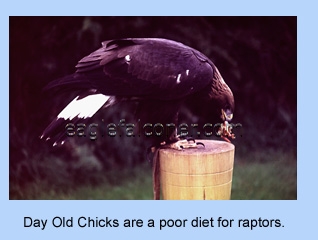 consuming a well balanced diet. consuming a well balanced diet.
Good food equals a healthy life, junk food equals a short life.
Strangely the more informed we humans become the more confused we seem to be as to what is, or is not, good food. If we have difficulty in knowing what a correct diet is for ourselves, then it is not surprising that some falconers do not understand the advantages of a good diet for their hawk.
Sadly far too many falconers and breeders rely too heavily on the highly overrated day old chick. It is after all nothing more than an egg in another form. High in cholesterol and phosphorus, low in calcium, and because it itself has not eaten, it is woefully low in those, vital minerals and trace elements that can be obtained from an adult carcass.
Would you really expect a human child, if fed a diet of nothing but eggs from the day it was born until adulthood, to then perform with any style and stamina as an athlete?
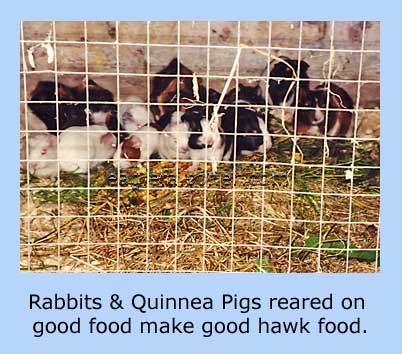 The fact a hawk does manage quiet well on such a diet, hides the potential improvement in performance and well-being if fed a well balanced natural diet. The fact a hawk does manage quiet well on such a diet, hides the potential improvement in performance and well-being if fed a well balanced natural diet.
Now as a simple rule, a natural diet for your hawk is to feed animal, and, or bird species that your hawk would normally catch in the wild.
A well trained hawk in hunting condition should easily sustain itself with a natural variety of food throughout the season, but it takes an exceptional hawk to supply enough food to sustain itself throughout the out of season months as well. This shortfall can be further aggravated if the falconer, quite rightly enjoys some of the game for the table.
The making up of this balance of the annual food supply becomes the responsibility of the falconer and he/she has a number options open to him/her.
A lot now will depend on the individual's circumstances, for instance, a sparrow trap on a roof or balcony could well supply enough out of season food for a sparrow hawk or small falcon.
To feed a large bird with this method might push the local sparrow population a bit hard, in this case we would 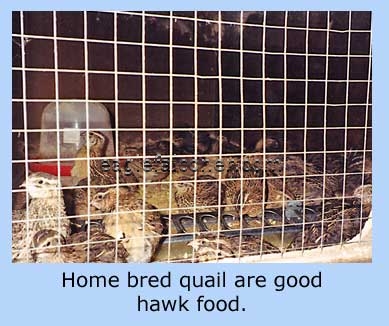 need access to open land with permission to shoot, ferret or the use of long dogs. The two latter methods procure clean game, unlike the first method which contaminates the food with lead. To reduce the risk of ingestion of lead, firstly never ever feed hawks food killed with a shotgun, only use game shot with a rifle, having first checked a bullet exit hole exists, if not dig out the bullet before feeding it to your hawk. There are also other methods of trapping game, but they all take a good deal of time and skill. need access to open land with permission to shoot, ferret or the use of long dogs. The two latter methods procure clean game, unlike the first method which contaminates the food with lead. To reduce the risk of ingestion of lead, firstly never ever feed hawks food killed with a shotgun, only use game shot with a rifle, having first checked a bullet exit hole exists, if not dig out the bullet before feeding it to your hawk. There are also other methods of trapping game, but they all take a good deal of time and skill.
The next best option is to pay a professional shooting man to obtain exactly what you require. This will generally mean that you will need ample freezer space, as a good shooting man will fill your order in a couple of outings. If obtaining wild hawk food presents you with some problems, there is now quite a professional market supplying captive bred food. Quail, laboratory rats and mice, day old cockerel chicks, turkey poults and rabbits.
There are good and bad suppliers of captive bred food, so don’t be put off, just be careful. In fact one of the best Bird of Prey breeding centres in the world, namely what was known as East Berlin Zoo, feeds all of its raptors on in-house (captive bred food, but with one important difference, they grow all the food which is fed to the animals which are reared as food species. These animals are provided with only fresh food, such as green plants, fruits, vegetables and seeds. In this way they believe that their birds of prey and owls receive food of a high nutritional standard and that vitamin and mineral supplements are unnecessary.
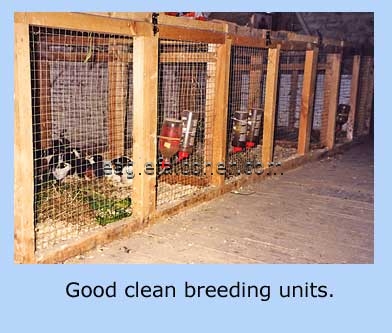 Few of us call provide captive reared food to that high standard, the alternative is usually reject stock from intensive. rearing units. It is highly unlikely that any of these animals have ever seen the light of day, receiving all its required vitamins, minerals together with antibiotics from the intensive high protein feed. Few of us call provide captive reared food to that high standard, the alternative is usually reject stock from intensive. rearing units. It is highly unlikely that any of these animals have ever seen the light of day, receiving all its required vitamins, minerals together with antibiotics from the intensive high protein feed.
Here again the importance of variety and quality comes to the fore, if you become reliant on one or two suppliers of captive reared food, it is imperative that you seek a good relationship with the proprietor, explaining why you need the very best of his product. Should he use for any reason medication on his stock, then you should know and have the right to refuse that particular batch. For what may be a harmless dose for one individual is going to multiply day by day in your hawk. Intensively reared rodents commonly carry insecticides and other chemicals, to which they themselves are tolerant, but will have disastrous results to your more susceptible hawk.
Vitamin, mineral and calcium supplements can be dangerous, essential or a waste of money. It all depends on the diet your hawk receives, here again we would do well to study the wild diet. You may think that because I have a medium sized hawk that preys on rabbits in the wild, if I feed rabbit every day then I am providing the best for my bird. Well yes and no, admittedly your hawk won’t come to a lot of harm, but it is unlikely to do as well as its wild cousin on the same diet. For unlike the wild bird we do not allow our hawks just to eat the choice bits, leaving the rest of the carcass to the lower order of scavengers. A wild rabbit catching hawk will first break through the rib cage and eat the vital organs, some flesh, bone, intestinal organs and a little fur. It will rarely need a full crop, finding this a little debilitating in flight, This balance of choice meats will be repeated at each feed, unlike its captive cousin who because of economics is required to eat the whole rabbit over a number of feeds. Thus reducing its ratio of the choice meats to about 25% of its total intake of food. The other 75% being solely flesh, bone and fur.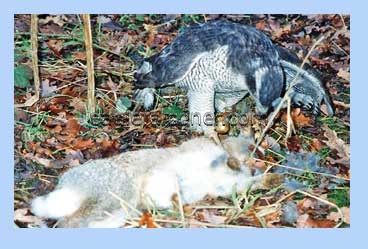
Although this will contain sufficient levels of protein, fat and carbohydrate it will have a lower level of essential vitamins and trace elements than the choice 25% that the wild bird lives on, This can be corrected by the addition of a small quantity of vitamin and mineral supplement.
As already mentioned, the worst end of the diet scale is the over used 'day old chick'. They contain large amounts of phosphorus and cholesterol and very small amounts of calcium. The cholesterol level can be reduced by squeezing out the yolk sack before feeding.
The calcium to phosphorus ratio required by birds from their diets is 1.5: 1, unfortunately a diet of 'day old chicks' provides 1.4:3, and so as calcium and phosphorus compete within the body this low level of calcium to phosphorus means that the calcium is poorly absorbed.
This calcium deficient diet requires supplementation with a concentrated calcium powder, otherwise the amounts required would overpower the food and make it unpalatable. In this type of diet the addition of bone flour (calcium phosphate) or SA37 which are both high in phosphate would only exaggerate the deficiency.
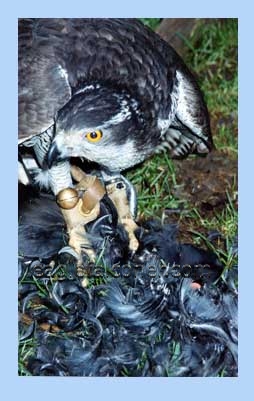 Two new mineral rich concentrated vitamin supplements are now available: VYDEX MVS-30 with a Ca:P ratio of 2.5: 1, and ARKVITS with a Ca:P ratio of 2: 1. It is easy to understand what deficiencies there are in the diet your hawk receives, and to redress them if necessary with the right supplementation, It is a total waste of money just adding the them to a correct and balanced diet, because it sounds like a good idea. Also one must be very careful not to be taken in by all the promotional literature offered by all the different products, and become hooked on the notion that a larger dose will do twice as much good, or mixing a cocktail of all the brands because you cannot make up your mind which is the best one. An overdose of vitamins can be just as fatal as vitamin deficiency. Two new mineral rich concentrated vitamin supplements are now available: VYDEX MVS-30 with a Ca:P ratio of 2.5: 1, and ARKVITS with a Ca:P ratio of 2: 1. It is easy to understand what deficiencies there are in the diet your hawk receives, and to redress them if necessary with the right supplementation, It is a total waste of money just adding the them to a correct and balanced diet, because it sounds like a good idea. Also one must be very careful not to be taken in by all the promotional literature offered by all the different products, and become hooked on the notion that a larger dose will do twice as much good, or mixing a cocktail of all the brands because you cannot make up your mind which is the best one. An overdose of vitamins can be just as fatal as vitamin deficiency.
Stick to one product, follow strictly to the manufacturers recommended dosage, if unsure err on the lower side and contact the manufacturer to discuss the diet you are feeding and ask their advice.
One product which has recently come to my attention and has impressed me by the amount of research carried out on it throughout the world, is ENTRODEX manufactured by Vydex Animal Health. It is a probiotic-electrolyte preparation which contains beneficial and non pathogenic micro organisms. In other words this preparation contains beneficial bacteria known as 'good bugs'. The gastrointestinal tract of animals and birds contain a delicate balance of good bugs' and 'bad bugs' (E.coli, Salmonella, etc.). These 'bad bugs' can result in infectious disease when the body's natural defences are disturbed. Stress, for example, can result in a change in the gut environment to favour the pathogenic species, ie, 'bad bugs'. Left unchecked diarrhoea would lead to dehydration and subsequent death.
There are many times during the life of a trained hawk when a situation can become stressful, during initial training, travelling or handling to carry out essential maintenance, ie, coping the beak, imping, etc.
A regular addition of ENTRODEX probiotic to your hawk's diet helps maintain a balanced gut environment. Which in turn improves the nutrient breakdown and absorption of that now excellent diet you are feeding to your hawk.
|
